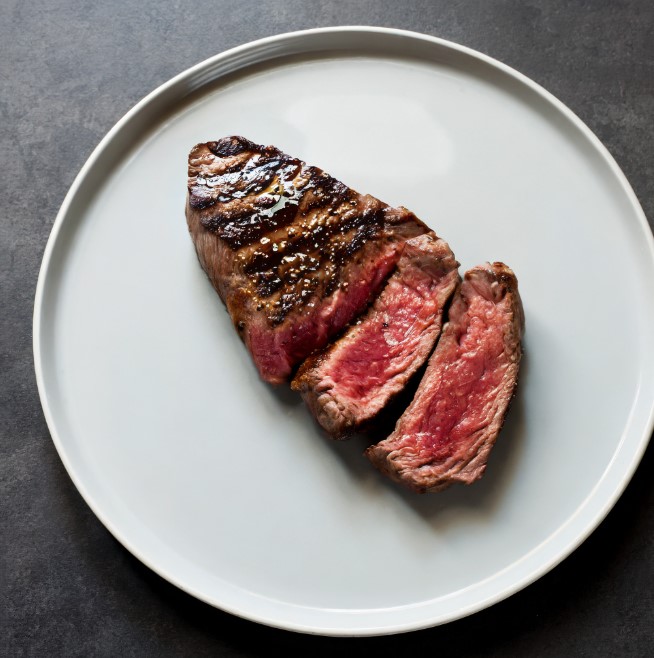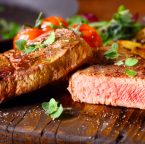If your goal is just to slim down without moving much, then yeah, cutting carbs and leaning on fats can do the job. But if you’re actually in the gym trying to build muscle, your body needs carbs. Not a little. A lot.
A good place to start is aiming for about 2 grams of carbs per pound of bodyweight each day. When you raise carbs, you usually have to pull fats down a notch to keep things balanced. It’s a tradeoff, but it works.
The low-fat craze of the ‘80s is long gone, but fat intake still matters. If you’re eating heavy carbs to put on size, you can’t just ignore it.
There’s no one-size-fits-all formula here. Your goals, your body, your training style, they all play a role. So let’s dig into what the research and an actual weight-loss doctor have to say about dialing this in the right way.

What Is A Low Fat Diet?
So what does a low-fat diet actually look like? In most cases, you’re talking about 20 to 35 percent of your calories coming from fat. Drop it even further and you’re in very low-fat territory, which means under 10 percent.
The big organizations all line up on this, World Health Organization, American Heart Association, USDA, they all suggest sticking in that 20 to 35 percent window. Put it into real numbers: if you weigh 180 pounds and eat around 2,500 calories a day, that’s 500 to 875 calories from fat, or roughly 55 to 97 grams.
Protein is where most athletes set their anchor. Around 0.8 to 1 gram per pound of bodyweight. For that same 180-pound lifter, that works out to 144 to 180 grams of protein daily, about a quarter of your calories. Solid, no surprises there.
So let’s build it out. At 2,500 calories, a balanced low-fat diet might break down like this: 162 grams of protein, 279 grams of carbs, and 76 grams of fat. That lands you at about 27 percent fat.
But athletes chasing performance usually push the carb-to-protein ratio higher. Something like 1:2 or even 1:3. If you ran 162 grams of protein and 405 grams of carbs, fat would sink to around 26 grams a day. That’s under 10 percent of your calories. That’s the classic very low-fat setup.(1)
Some athletes go even further. Dr. Aastha Kalra, a physician in New York, points out that intense training, think four hours a day, can push carb needs to 12 grams per kilo of bodyweight. For a 180-pound athlete, that’s huge, and total calories would probably climb over 3,500 a day. Yet fat would still sit low, almost as an afterthought.(2)
And that’s the big question. Can you really train hard, recover well, and grow muscle with fat that low? Or are you setting yourself up to run out of gas?

Can You Gain Muscle With Low Fat, High Carb?
Carbs are the engine that drive athletes. If you’re serious about building muscle and performing at your best, they’re not optional. They’re non-negotiable.(3)
It’s not just about having energy to get through a workout. Carbs are the fastest, most efficient fuel source for high-intensity training. They feed your fast-twitch fibers and keep your glycogen stores full. When those tanks run empty, performance nosedives. Dr. Kalra makes this clear, without carbs, recovery slows and output suffers, especially if you’re training hard day after day.
Low-carb diets? They come with a price. Cognitive dips, muscle breakdown, even dehydration risks. One study on elite race walkers showed exactly that: switching to low-carb, high-fat wrecked their performance economy. That’s not what you want when every rep, every stride, every lift matters.
Carbs also bring a powerful hormonal advantage. They boost insulin, which helps shuttle protein and nutrients into your muscles.(4) That’s why carb-loading has been a go-to for athletes looking to pack on real size. It works.
Now, fats can’t be ignored either. They’re critical for vitamin absorption, overall energy, and most importantly, hormonal balance. Polyunsaturated fats in particular have been linked to healthy testosterone levels, which means better strength, mood, and body composition. Skip fat altogether and you’re asking for trouble.(5)(6)
So where should you land? Aiming for about 20 percent of your calories from fat is a strong starting point. It gives you enough for hormone health without stealing room from the carbs you need to fuel performance.
At the end of the day, there’s no single formula that works for everyone. Some athletes thrive on very low fat, others crash on it. Pay attention to your body, your training, and your results. It’ll tell you if you’re getting it right.

Does Low Fat Work Well For Weight Loss?
When it comes to weight loss, people love to argue low fat versus low carb. The truth? Both camps miss the bigger picture. At the end of the day, it’s calorie balance that decides whether the scale moves up or down. That’s the real driver, not just shuffling macros around.
Now, research does throw fuel on both fires. Some studies point to low fat giving a slight edge in fat loss when calories are matched.(7) Others show low carb working better in certain groups.(8)(9) And then you’ve got the health angle, cholesterol, blood sugar, long-term risks, all adding to the noise.(10)(11)
One of the best studies we’ve got on this came out in 2018. Over 600 people were followed for a full year, and when the dust settled, there was no real difference in weight loss between the low-fat and low-carb groups. Both worked when calories were controlled.
Dr. Kalra highlights the key detail here: the biggest wins came from cutting out sugar, refined flour, and processed junk. For people with insulin resistance or other metabolic issues, low carb might still be the sharper tool. But for athletes and lifters? That difference shrinks, because your body is already primed to use fuel more efficiently.
For the average person though, precision matters less. Most aren’t tracking macros like a bodybuilder weighing chicken breasts. The real question is sustainability. Which style of eating can you stick to without falling off the wagon? That’s what makes or breaks results.
If you’re an athlete chasing fat loss without sacrificing strength or performance, the smarter play is adjusting carbs and calories based on training demands. Fuel hard on the days you train, pull back on the lighter days, and keep your deficit steady. That way you’re not just losing weight, you’re holding onto muscle and staying sharp in the gym.
Should You Cycle Your Fat Intake?
Thinking about cycling your fat intake? The smarter move might be blending ideas from both low carb and low fat diets. Instead of locking yourself into one camp, adjust calories and carbs based on your training schedule. On the days you’re lifting heavy, push the carbs up. On lighter days or rest days, pull them back. Simple, but it works.
Dr. Kalra is a big supporter of carb cycling, especially around workouts. It comes down to glycogen, the fuel your muscles and liver burn through when you’re training hard. By loading carbs before, during, and after training, you make sure the tank is full when you need it most. That means better performance, better recovery, and fewer wasted sessions.
For athletes, the approach is pretty straightforward. Eat more carbs and calories on training days, scale it back on off days, and if you want, slide fats up a little when carbs come down. The payoff? Better insulin sensitivity, better appetite control, and a system that feels sustainable instead of restrictive.
Take someone eating 2,500 calories a day. If fat loss is the goal, you could create a weekly 3,500 calorie deficit, enough for a pound of weight loss, by pulling calories mostly from your rest days. Training days stay fueled, recovery stays sharp, and progress keeps moving. Flip it for muscle gain: eat more on the days you train, hold steady on rest days.
That said, if you’re an athlete training hard nearly every day, cutting carbs on “rest days” might backfire. Recovery is still work, and it still needs fuel. For those athletes, keeping carbs consistently high often makes more sense.
Final Word
At the end of the day, it all comes back to balance. Calories drive the scale, but performance and health depend on more than just hitting a number. Athletes need enough carbs to fuel hard training and enough fats to keep hormones and recovery on point. Micronutrients matter too, ignore them and you’ll feel it.
A solid rule is keeping at least 20 percent of your calories from fat, but remember, every body runs a little different. If you really want to dial it in, sit down with a sports nutritionist or dietitian who can map out a plan built for your goals. That’s how you get results that last, in the gym and beyond.
References
1. Liu AG, et al. A healthy approach to dietary fats: understanding the science and taking action to reduce consumer confusion. Nutr J. 2017 Aug 30;16(1):53.
2. Kanter M. High-Quality Carbohydrates and Physical Performance: Expert Panel Report. Nutr Today. 2018 Jan;53(1):35-39.
3. Burke LM, et al. Low carbohydrate, high fat diet impairs exercise economy and negates the performance benefit from intensified training in elite race walkers. J Physiol. 2017 May 1;595(9):2785-2807.
4. Dimitriadis G, et al. Insulin effects in muscle and adipose tissue. Diabetes Res Clin Pract. 2011 Aug;93 Suppl 1:S52-9.
5. Mumford SL, et al. Dietary fat intake and reproductive hormone concentrations and ovulation in regularly menstruating women. Am J Clin Nutr. 2016 Mar;103(3):868-77.
6. MInguez-Alarcón L, et al. Fatty acid intake in relation to reproductive hormones and testicular volume among young healthy men. Asian J Androl. 2017 Mar-Apr;19(2):184-190.
7. Hall KD, et al. Calorie for Calorie, Dietary Fat Restriction Results in More Body Fat Loss than Carbohydrate Restriction in People with Obesity. Cell Metab. 2015 Sep 1;22(3):427-36.
8. Volek J, et al. Comparison of energy-restricted very low-carbohydrate and low-fat diets on weight loss and body composition in overweight men and women. Nutr Metab (Lond). 2004 Nov 8;1(1):13.
9. Aude YW, et al. The national cholesterol education program diet vs a diet lower in carbohydrates and higher in protein and monounsaturated fat: a randomized trial. Arch Intern Med. 2004 Oct 25;164(19):2141-6.
10. Seidelmann SB, et al. Dietary carbohydrate intake and mortality: a prospective cohort study and meta-analysis. Lancet Public Health. 2018 Sep;3(9):e419-e428.
11. Dehghan M, et al. Associations of fats and carbohydrate intake with cardiovascular disease and mortality in 18 countries from five continents (PURE): a prospective cohort study. Lancet. 2017 Nov 4;390(10107):2050-2062.








